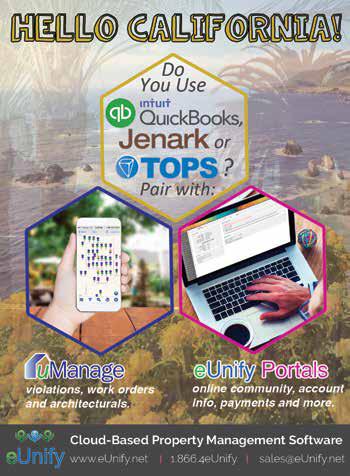
2 minute read
In the Boardroom
In 2016, CACM conducted a market characterization study of California common interest developments (CIDs). The purpose was to create some benchmarks for the industry – including type and quantity of associations, budgets and reserves – and better understand board challenges and products and services needed in the future.
Study respondents overwhelmingly pointed to recruitment and development of new board members as the greatest challenge facing their communities. As these are volunteer positions, finding homeowners with the time and temperament necessary to carry out the fiduciary responsibilities that a board position entails is no easy task.
Becoming a board member can seem a bit daunting, and if you have stepped up to the challenge, bravo to you. As a board member, you will not only provide an important service to your entire community, but also help to maintain the value of what is likely your biggest personal investment – your home.
Board members have many responsibilities, but it is critical to remember that your role is to govern, not to manage, or even worse, to micromanage your association’s community manager and service providers. The market characterization study found that 84 percent of California CIDs are professionally managed. If your association employs a professional community manager, it may be helpful to
review the management contract so that you understand their responsibilities. Professional community managers – particularly managers that have been certified by CACM – are well equipped to perform their duties.
Still, there is a lot to learn to be an effective board member. You will need to be familiar with the Davis-Stirling Act, the law that applies to California HOAs, as well as the specific provisions found in your CC&Rs. In addition, you will need to understand the basics of conducting meetings, budgeting and reserve assessments and running annual meetings and elections.
As a board member, you will be required to: • Act as a fiduciary for your association • Exercise proper care in making decisions • Maintain loyalty to your association and owners • Act in accordance with the governing documents • Act in “good faith” and in the best interest of the association • Make reasonable inquiry as the basis for decisions • Maintain appropriate confidentiality
Fortunately, while there is a lot to learn and do, there are some excellent resources to help you prepare to execute your responsibilities. Your professional community manager is well-versed in the 1,200 laws that apply to California HOAs and has proven expertise in community management. She/he is a great source of information and advice, and will be a valuable partner during your tenure on the board.
And, because your manager is a member of CACM, she/he soon will be able to share board training modules for you to view at your own pace, on-demand, to help you be the best board member you can.
Ask your manager for more information coming this fall.
CACM’s “In the Boardroom” feature is intended to provide key trends, tips and practical advice for association board members. For easy sharing, you can also access this and other archived articles online at www.cacm.org
Our dedicated experts understand the needs of community associations.
Finance your essential projects: • Building Repairs • Improvement Projects
Contact us today: Grant Shetron
Northern California 510-406-3198 GShetron@popular.com
Larry Hooper
Southern California 714-864-5171 LHooper@popular.com
1-800-233-7164 www.associationbankers.com
Subject to credit approval. ©2017 Banco Popular North America. Member FDIC.








